Z-Wave & WiFi Group Control: WiFi Quick Start Procedure
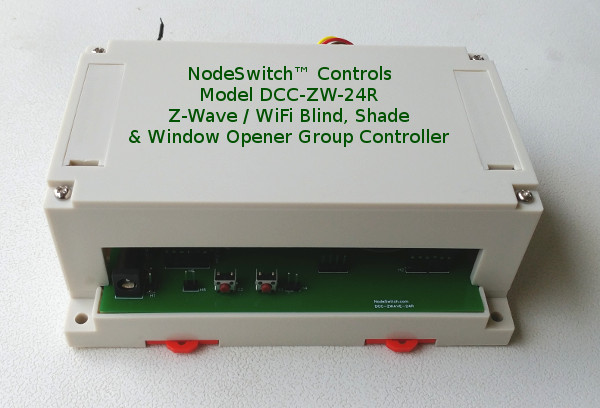 In Part 2 of this article series, we saw how to quickly pair the Z-Wave section of this controller with your Z-wave hub.
In Part 2 of this article series, we saw how to quickly pair the Z-Wave section of this controller with your Z-wave hub.
This article discusses the procedure for pairing your blind and shade controller with your WiFi network. If you haven't yet assigned your radio motors to the transmitter, please see Part 1A: Cloning Motor Channels that explains how to do this.
If you have successfully activated the default Z-Wave mode and wish to explore the WiFi mode, please press and hold Switch 3 (long press) to re-start the controller in WiFi mode (please see Part 2 for location of Switch 3).
You will be able to re-start the unit in Z-Wave mode later by changing a setting in the browser display.
This unit also has an OLED display built into it that may help prompt you through the process.
To expose the OLED display, you can view it simply by removing the 4 corner screws that hold the cover on.
However, it is not necessary to use the OLED, as the unit will automatically start the web server and display a web page that you can connect to for further instructions.
Connecting to Your Temporary AP (Access Point) Mode
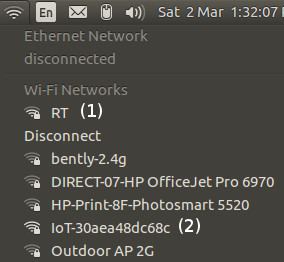 The web server starts out in AP (Access Point) mode, broadcasting a signal that will make it appear in your WiFi network selection menu.
The web server starts out in AP (Access Point) mode, broadcasting a signal that will make it appear in your WiFi network selection menu.
The WiFi list will also typically display your neighbor's routers too; this picture shows what the WiFi selection list looks like on a Linux laptop (we use Ubuntu Linux).
Mac and Windows machines will have similar "pick lists", as do Android and IOS on mobile units.
On the picture we have marked our existing network (1) that needs to be disconnected (it is called "RT"); your system will display your WiFi network name (SSID). Please note that you will need to know your password.
We have also marked the controller ID as (2), which you will connect to temporarily so that you can enter the ID and password of your regular WiFi network. Please note that while in AP mode, the controller ID always starts with "IoT-" followed by the unique Chip ID.
 The OLED screen will also display this message on the screen, prompting you to connect your WiFi to the AP (Access Point) mode of the controller.
The OLED screen will also display this message on the screen, prompting you to connect your WiFi to the AP (Access Point) mode of the controller.
It may take up to a minute for the SSID to show up in your list of networks, but if you disconnect from your current WiFi it will show up faster (the disconnect prompts a refresh of the available WiFi network list).
When you disconect your existing network and connect to the controller access point ID, your system should prompt you for a password; it will be this:
Password: aabbccddee
If you enter the password, your system should connect to the controller, displaying the access point as the current connection in the WiFi pick list.
Setting Your WiFi Parameters While AP (Access Point) Mode Is Active
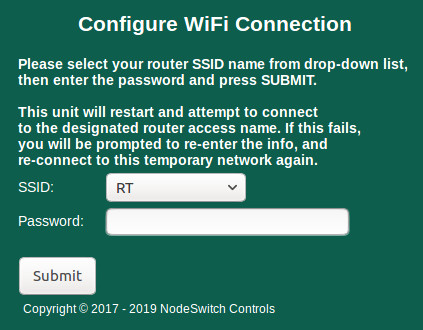 Once you have connected successfully to the AP WiFi mode, a wifi configuration screen will appear in your browser at this location (pictured):
Once you have connected successfully to the AP WiFi mode, a wifi configuration screen will appear in your browser at this location (pictured):
IP address: 192.168.4.1
Please type this address into your browser address bar (where you would normally type a website URL).
The microprocessor will have already scanned the local WiFi radio wave emissions to generate a list of WiFi access points, and this information will appear in the dropdown selector that you see as the first item on the above WiFi config page. Your regular WiFi network will likely be the default that is displayed, because the system sorts by signal strength.
When you have selected your network SSID and entered your WiFi password, please press the SUBMIT button; this will cause a Javascript pop-up dialog to appear, giving you a final chance to check your entries. Click OK to save this configuation and reboot the controller.
After You Have Successfully Connected to Your WiFi Network
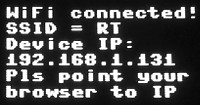 When it starts up again, the controller will attempt to connect to your specified network in 'Station' mode. This is normally a very fast sequence, less than a second, and the OLED display should also indicate that you are successfully connected to your WiFi network (pictured).
When it starts up again, the controller will attempt to connect to your specified network in 'Station' mode. This is normally a very fast sequence, less than a second, and the OLED display should also indicate that you are successfully connected to your WiFi network (pictured).
The controller will also detect and display the new IP address that the DHCP system in your router assigned to it. The software will then begin a 30 second period to allow your laptop (or other device) to disconnect from the temporary Access Point (AP) mode and re-connect to your regular WiFi signal, with the newly assigned IP address.
Please note: If you enter the wrong password, or pick the wrong network, the unit will cycle back to AP mode so that you can try again. Please allow up to a minute for the system to be re-set, then follow the instructions above (Connecting to Your Temporary AP (Access Point) Mode).
Assigning A Static IP Address With Your WiFi Router
The DHCP system built into your WiFi router automatically assigns a local IP address anytime you connect a device to your WiFi network, whether it is a tablet, laptop, phone, or our controller. Typical home routers can issue up to about 250 different local IP addresses. Please Note: this is not the same as your public IP address, which is assigned by your Internet service provider.
The DHCP system will not always assign the same IP address to your unit. When a unit like our controller has a built-in web server, it is a good idea to bypass the DHCP system and assign a local static IP address, so that it will always be available at the same IP address, and you can bookmark your controller in your local browser.
Many routers also allow you to change the "hostname" to something like "Blinds 1", so that you can distinguish between controllers by name and IP address, when you review the list of devices connected to your WiFi router, in the router administration.
You will need know how to login to the administrative section of your router to do this, and although it is generally similar, the process will vary from manufacturer to manufacturer. For more instructions, please search the internet for your router model number, or consult your WiFi router user manual.
If you have entered incorrect WiFi connection information, or the device cannot connect (for whatever reason), the controller will make 30 attemps to connect (in case you happened to cycle power on your WiFi router) before it gives up. It will timeout at that point and reboot, bringing up the WiFi config screen again. It will continue this loop procedure until you input the correct configuration settings.
Rebooting the Microprocessor
This unit uses a powerful microprocessor that can be re-booted, if you need to do this for whatever reason. It is not normally necessary, so it should be used with care. It does the same thing as unplugging the controller unit from the 24v DC power.
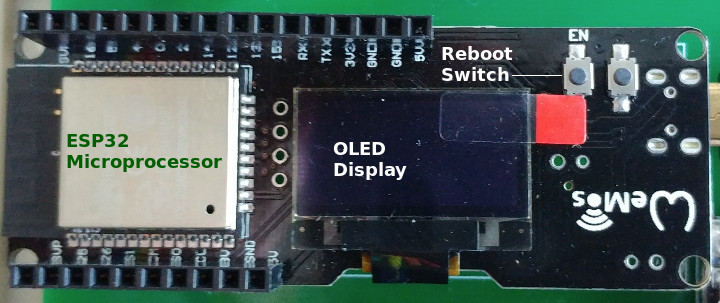
Purchase This Unit in Our Online Store
You can purchase our Unity group controller for blinds and window openers, and our other control products in our online DIY automation store.
Adrian Biffen
Senior Partner
NodeSwitch™ Controls
We sincerely hope you enjoy our advanced technology products; if you have any questions, please contact us at any time!
Articles in this series:
Part 1: Z-Wave Group Control of Blind & Shade Motors: Introduction
Part 1A: Z-Wave & WiFi Blind Control: Cloning Motor Channels
Part 2: Blind Motor Quick Start Pairing With Your Z-Wave Hub
Part 3: Blind Motor Quick Start Pairing With Your WiFi Network (you are here)
Part 4: Welcome to the WiFi Home Page
Part 5: Understanding the Controller Settings
Part 6: WiFi Slider Control for Motorized Blinds, Shades, and Window Openers

 Shopping Cart Home - Start Here
Shopping Cart Home - Start Here Z-Wave Motor Control
Z-Wave Motor Control Remote Controls for Radio Equipped Motors
Remote Controls for Radio Equipped Motors DIY Starter Kits for Window Shades
DIY Starter Kits for Window Shades DIY Starter Kits for Window Openers
DIY Starter Kits for Window Openers Alexa & Broadlink RM4 Pro Home Theater Control
Alexa & Broadlink RM4 Pro Home Theater Control Zwave Motor Control: Introduction
Zwave Motor Control: Introduction Shelly WiFi Wireless Motor Control
Shelly WiFi Wireless Motor Control Zigbee Motor Control (Under Development)
Zigbee Motor Control (Under Development) Raspberry Pi as a Home Automation Hub
Raspberry Pi as a Home Automation Hub Hubitat Elevation & Broadlink RM Pro Emitter
Hubitat Elevation & Broadlink RM Pro Emitter Blind Motors
Blind Motors Window Openers
Window Openers Skylight Openers
Skylight Openers Shade Slider
Shade Slider Curtain Closer
Curtain Closer Track Glider
Track Glider Background & Mission Statement
Background & Mission Statement Customer DIY Testimonials
Customer DIY Testimonials Contact Page
Contact Page